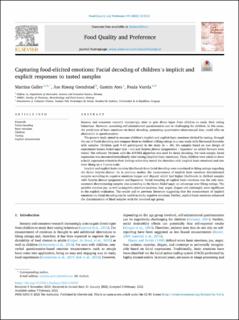| dc.description.abstract | Sensory and consumer research increasingly aims to gain direct input from children to study their eating behaviour. However, answering self-administered questionnaires can be challenging for children. In this sense, the prediction of basic emotions via facial decoding, generating quantitative observational data, could offer an alternative to questionnaires. The present study aimed to measure children’s implicit and explicit basic emotions elicited by tasting, through the use of facial decoding and compare them to children’s liking ratings in a case study with flavoured chocolate milk samples. Children aged 9–10 participated in the study (n = 48). Six samples based on two design of experiment factors Added sugar (yes / no) and Surprise flavour (peppermint / liquorice/ no added flavour) were tested. The software iMotions with the AFFDEX algorithm was used for facial decoding. For each sample, facial expression was measured immediately after tasting (implicit basic emotions). Then, children were asked to show a facial expression related to their feelings when they tasted the chocolate milk (explicit basic emotions) and rate their liking on a 7-point-scale. Implicit and explicit basic emotion likelihoods from facial decoding were correlated to liking ratings regarding the factor Surprise flavour. As in previous studies, the measurement of implicit basic emotions discriminated samples according to negative emotions (anger and disgust) which had higher likelihoods in disliked samples with Surprise flavour (peppermint and liquorice). Facial decoding of explicit basic emotions was the only measurement discriminating samples also according to the factor Added sugar, an advantage over liking ratings. The positive emotion joy, as well as negative emotions (sadness, fear, anger, disgust and contempt), were significant in the explicit evaluation. The results add to previous literature suggesting that the measurement of implicit emotions via facial decoding can be useful to study negative emotions. Further, explicit basic emotions enhanced the discrimination of liked samples with the involved age group. | |
